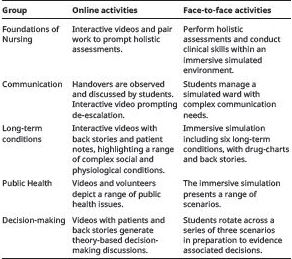
Simulated practice has become ever-more common within undergraduate nursing programmes. This initiative looks to further this practice by asking students to create simulations, thus developing their ability and knowledge surrounding application of theory to practice.
Twenty-five level-five adult nursing students attended a four-week placement where they created virtual and face-to-face simulations. Five groups focused on one module each, and used the learning outcomes of the module, the clinical skills pertinent to the associated part of the programme, and their experiences to create three days of online simulation and one day of face-to-face simulation. The students presented their simulations to the adult nursing lecturers. As no simulations were run over this time, the effectiveness and monitoring of the placement consisted of daily informal conversations with students.
Table 1 presents an overview of the activities produced against the learning outcomes.

 |
The five student groups focused on the following themes:
Group one: Foundations of nursing.
Group two: Communication.
Group three: Long-term conditions.
Group four: Public health.
Group five: Decision-making.
After the end of the placement, the students stated ‘I don’t feel it’s fair that we have had this experience and others haven’t. I have progressed far more, and now understand how to apply the theory to practice’ and ‘I now understand how university learning and practical learning work together’.
Self-Learning Methodology in Simulated Environments (MAES) (Spanish acronym) is a pedagogy that encourages student groups to develop their own simulations [1,2]. Groups are carefully formed and developed to create a group identity. The co-reliance is used to motivate students, leading to increased confidence and professional identity [1]. This has shown to enhance retention of learning more than simulation alone [2]. Although the placement discussed did not perform the simulations within the timeframe described, the students were engaged within their groups, demonstrating innovation and self-development, with pride in their outcome. Namely, the students were aware that their creations would be used with other students, presenting empowerment and accountability. Belonging, interdependence and empowerment are all predictors of motivation [3].
The act of creating and innovating simulations motivates students to explore concepts in greater depth. As a result, students achieve cognitive flexibility within their learning, highlighting an ability to use it within multiple settings. Also, the act of creating learning experiences which are used for other students provides a sense of pride and subsequent engagement.
1. Díaz JL, Leal C, García JA, Hernández E, Adánez MG, Sáez A. Self-learning methodology in simulated environments (MAES©): elements and characteristics. Clinical Simulation in Nursing. 2016;12(7):268–274.
2. Peñataro-Pintado E, Díaz-Agea JL, Castillo I, Leal-Costa C, Ramos-Morcillo AJ, Ruzafa-Martínez M, Rodríguez-Higueras E. Self-learning methodology in simulated environments (MAES©) as a learning tool in perioperative nursing. An evidence-based practice model for acquiring clinical safety competencies. International Journal of Environmental Research and Public Health. 2021;18(15):7893.
3. Perry C, Henderson A, Grealish L. The behaviours of nurses that increase student accountability for learning in clinical practice: An integrative review. Nurse Educ Today. 2018;65:177–186.